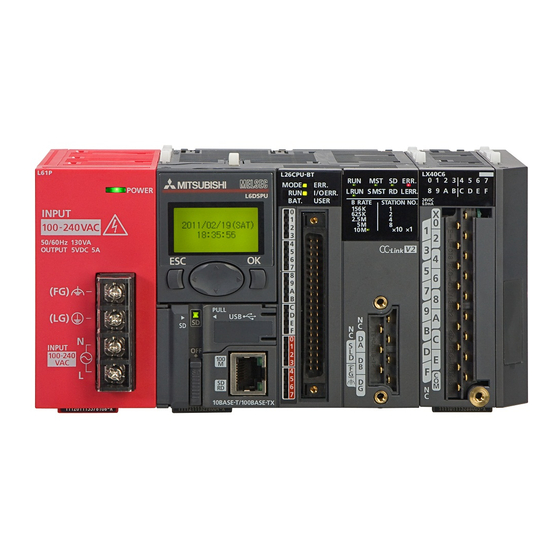
Table of Contents
Advertisement
Quick Links
Advertisement
Table of Contents

Summarization of Contents
SAFETY PRECAUTIONS
DESIGN PRECAUTIONS
Precautions related to the design and installation of the module to prevent malfunction or accidents.
INSTALLATION PRECAUTIONS
Precautions for installing the module to prevent malfunction, breakdown, or electric shock.
WIRING PRECAUTIONS
Precautions for wiring the module to prevent noise, fires, or malfunctions.
STARTUP/MAINTENANCE PRECAUTIONS
Precautions for starting up and maintaining the module to prevent failures or malfunctions.
DISPOSAL PRECAUTIONS
Guidance on handling the product as industrial waste when disposing of it.
1 OVERVIEW
1.1 Features
Details the key features of the QD62(E/D) high-speed counter modules.
2 SYSTEM CONFIGURATION
2.1 Applicable Systems
Describes the applicable CPU modules and base units for QD62(E/D) installation.
2.3 About Use of the QD62 (E/D) with the Q12PRH/Q25PRHCPU
Explains how to use QD62(E/D) with specific QCPU models and GX Configurator-CT limitations.
2.4 About Use of the QD62 (E/D) on the MELSECNET/H Remote I/O Station
Details usage and limitations when QD62(E/D) is on a MELSECNET/H remote I/O station.
2.5 How to Check Software Version
Guides on how to check the GX Configurator-CT software version within GX Developer.
3 SPECIFICATIONS
3.1 Performance Specifications
Details the performance specifications for the QD62, QD62E, and QD62D modules.
3.2 Function List
Lists the available functions of the QD62(E/D) and their corresponding reference sections.
3.3 I/O Signals for the Programmable Controller CPU
Details the input and output signals for the QD62(E/D) and their device numbers.
3.4 Buffer Memory Assignments
Lists the buffer memory assignments for the QD62(E/D), including addresses and functions.
3.5 Interface with External Devices
Lists the external device interface details for the QD62, QD62E, and QD62D modules.
3.6 Encoders that can be Connected
Describes the types of encoders that can be connected to QD62/QD62E and QD62D modules.
4 SETUP AND PROCEDURE BEFORE STARTING THE OPERATION
4.1 Handling Precautions
Provides essential precautions for safely handling the QD62(E/D) module during installation and use.
4.2 Procedure Before Starting the Operation
Outlines the step-by-step procedure to follow before starting the QD62(E/D) operation.
4.3 Part Identification Nomenclature
Identifies and names the parts of the QD62(E/D) module, including LEDs and connectors.
4.4 Wiring
Details wiring precautions to ensure system reliability and minimize noise effects for high-speed pulse input.
4.4.2 Wiring example of a module and an encoder
Shows wiring examples for connecting various encoder types to QD62/QD62E and QD62D.
4.4.3 Wiring example of a controller and an external input terminal
Provides wiring examples for connecting controllers to external input terminals at different voltage levels.
4.4.4 Wiring example with an external output
Shows wiring examples for external outputs (EQU terminals) for QD62/QD62D and QD62E.
4.4.5 Using the connector/terminal block converter module
Illustrates wiring when using a connector/terminal block converter module with the QD62(E/D).
4.5 Switch Settings for the Intelligent Function Module
Explains how to configure the intelligent function module switches for pulse input, speed, and counter format.
5 BASIC USAGE
5.1 Pulse Input and Counting Method
Explains six types of pulse input methods and their corresponding count timings for QD62(E/D).
5.2 Selecting the Counter Format
Describes how to select between linear and ring counter formats and their operations.
5.3 Using the Coincidence Output Function
Explains how the coincidence output function compares count values and generates signals.
5.4 Using the Preset Function
Describes how to use the preset function via sequence program or external control signals.
6 CONVENIENT USAGE
6.1 Selecting the Counter Function
Details how to use disable count, latch counter, sampling counter, and periodic pulse counter functions.
6.1.2 Count error
Explains how to calculate count errors due to input response delay or internal clock.
6.2 Using the Disable Count Function
Describes how the disable count function stops counting when the count enable command is ON.
6.3 Using the Latch Counter Function
Explains how the latch counter function latches the present counter value at a signal entry.
6.4 Using the Sampling Counter Function
Details how the sampling counter function counts pulses during a specified sampling time period.
6.5 Using the Periodic Pulse Counter Function
Explains how the periodic pulse counter function stores present and previous values for each periodic time.
7 UTILITY PACKAGE (GX Configurator-CT)
7.1 Functions of the Utility Package
Lists the functions of the GX Configurator-CT utility package for QD62(E/D) operation.
7.2 Installing and Uninstalling the Utility Package
Provides instructions and precautions for installing and uninstalling the GX Configurator-CT utility.
7.2.2 Operating environment
Explains the operating environment requirements for the personal computer running GX Configurator-CT.
7.3 Explanation of Utility Package Operations
Explains common utility operations using control keys and data handling in GX Developer.
7.3.2 Operation overview
Provides an overview of operating GX Developer and accessing the Intelligent Function Module utility.
7.3.3 Starting the Intelligent function module utility
Explains how to start the intelligent function module utility and activate screens for parameter setting and monitoring.
7.4 Initial Settings
Guides on performing initial settings for QD62(E/D) channels using the utility package.
7.5 Auto Refresh
Explains how to set QD62(E/D) buffer memory for automatic refresh, eliminating sequence program needs.
7.6 Monitoring/Test
Explains how to start buffer memory and I/O signal monitoring/testing using the utility.
8 PROGRAMMING
8.1 Program Example When GX Configurator-CT is Used
Presents program examples for QD62(E/D) when using GX Configurator-CT.
8.2 Program Example when GX Configurator-CT is not Used
Presents program examples for QD62(E/D) when GX Configurator-CT is not used.
8.3 Example of a Program Using the Coincidence Detection Interrupt Function
Demonstrates a program example for coincidence detection interrupt function setup and logic.
9 TROUBLESHOOTING
9.1 Error Information
Lists potential errors like overflow and fuse break, and their detection locations and actions.
9.2 When the QD62(E/D) Does Not Start Counting
Guides on troubleshooting steps when the QD62(E/D) fails to start counting properly.
9.3 When the QD62(E/D) Does Not Normally Count
Provides troubleshooting steps for issues related to the QD62(E/D) not counting normally.






Need help?
Do you have a question about the MELSEC QD62D and is the answer not in the manual?
Questions and answers